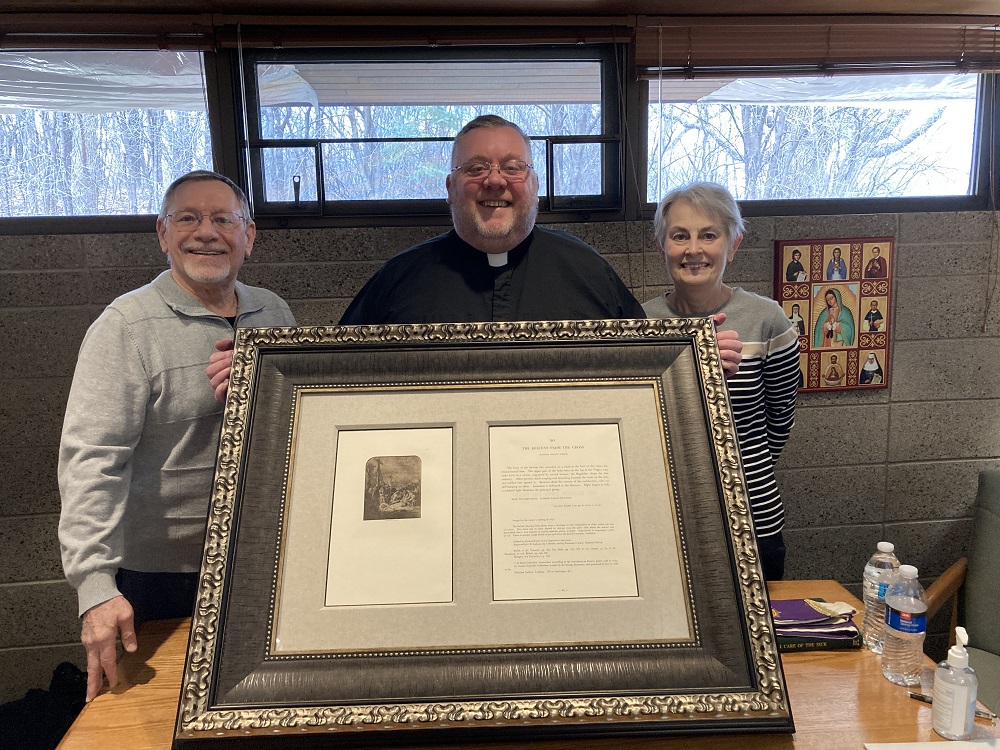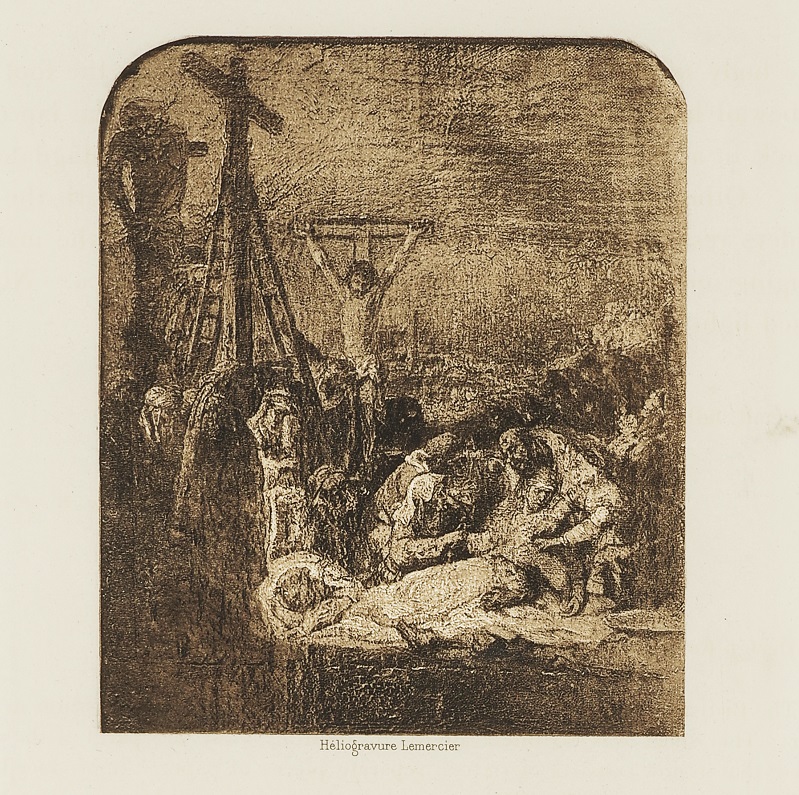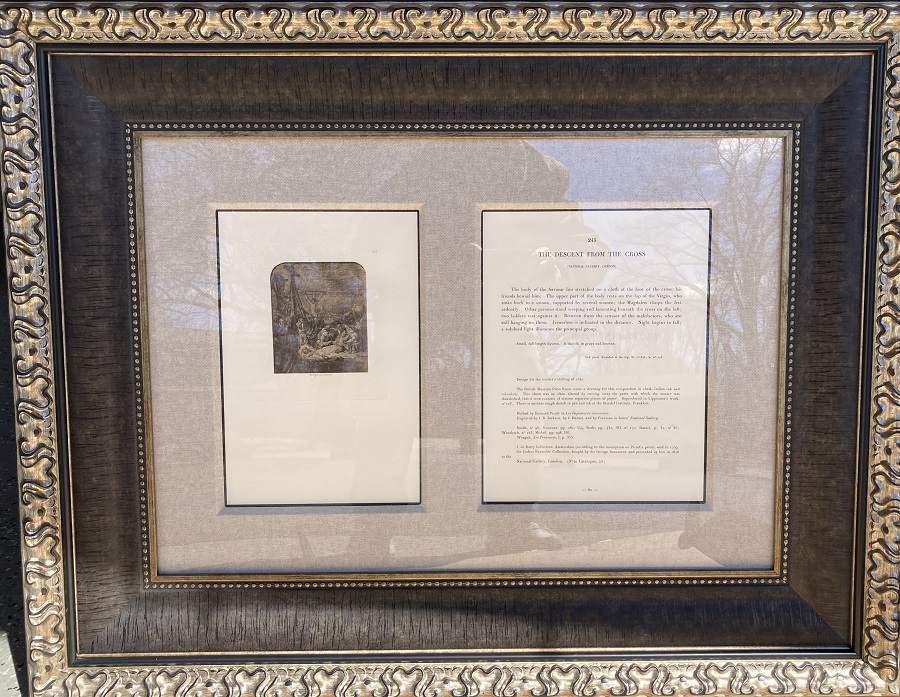Park West Collectors Donate Rembrandt Work to Local Church for Easter
The Easter season is a sacred time for people all around the world, but two long-time Park West collectors in Minnesota found an extraordinary way to make Easter even more special for their church this year—they gave them a Rembrandt.
The Rembrandt in question is a stunning antique intaglio of one of the artist’s most iconic images “The Descent from the Cross,” showing Jesus being taken down from the cross by his friends and family on Good Friday.
Scott and Terry Jurek made the decision years ago that they wanted to donate a historically significant work of art to their church, St. John Neumann Catholic Church in Eagan, Minnesota, but it wasn’t until recently that they finally found the perfect work and the perfect time to donate it.

Scott and Terry Jurek present “The Descent from the Cross” to Fr. Tony O’Neill at St. John Neumann in Minnesota
“I’m a four-time survivor,” Scott said. “Two times for cancer and two times for my heart. And, during my recovery, I drew a stronger connection to my church, and I was also really touched by all of the cards and flowers and outreach I received from my friends at Park West. I wanted to honor those relationships.”
Scott and Terry started collecting art over five years ago during a Panama Canal cruise where they first encountered Park West. Since then, the couple has turned their home into a veritable museum, featuring works by over twenty artists. Terry describes their taste in art as “eclectic.”
“Once we got the idea, we started asking ourselves ‘Is there a special artwork we could present to the church itself for Easter?’” Scott remembers. “We immediately started thinking of a Rembrandt or Albrecht Dürer. They both created graphic series about the Passion of the Christ. So, we started working with Park West to find what we were looking for.”
The couple credits Park West’s Senior Gallery Director Morris Shapiro for all of his hard work in helping them find an ideal Rembrandt to present to their church.
“There were several others Rembrandts that I initially had some interest in,” Scott said. “I explained to Morris our intent to locate one. So, he tirelessly started going through Park West’s archives until he found this ‘Descent of the Cross,’ and immediately we knew we had found the right one.”

Detail from Rembrandt’s “Descent from the Cross”
The “Descent of the Cross” they found was a heliogravure, which was the first marriage of photography and intaglio printmaking, created in 1822. The heliogravure produced the finest quality of interpretation of painting in printing, available at the time and, as it employed the intaglio printing process and fine art printing papers, yielded qualities comparable to fine art etching, a technique of which Rembrandt also mastered.
The Jureks’ “Descent” was printed between 1897 and 1905 and comes from an eight-volume set, The Complete Works of Rembrandt—History, Description, and Heliographic Reproduction of All the Master’s Pictures with a Study of His Life and His Art. The heliogravure was accompanied by descriptive text from the National Gallery in London, and Jureks felt strongly that the text had to accompany the image.
“We actually went back and forth with Park West several times trying to figure out the best way to frame the image and text together,” Scott said. “The text brings out the detail so well. When we showed it to our pastor, he was, of course, drawn to the image, but when he read the National Gallery description, he stopped talking. It was an emotional experience.”

Photo of the final framing that the Jureks decided on for “Descent from the Cross”
The National Gallery summary of “The Descent from the Cross” reads as follows:
“The body of the Saviour lies stretched on a cloth at the foot of the cross; his friends bewail him. The upper part of the body rests on the lap of the Virgin, who sinks back in a swoon, supported by several women; the Magdalen clasps the feet ardently. Other persons stand weeping and lamenting beneath the cross on the left; two ladders rest against it. Between them the crosses of the malefactors, who are still hanging on them. Jerusalem is indicated in the distance. Night begins to fall; a subdued light illumines the principal group.”
Now that the Jureks knew what Rembrandt they wanted to share with their church, they only had one problem—they wanted to present it before Easter 2022.
“After being 23 years in the military,” Scott said. “I understand a lot about the logistics involved in framing and shipping art that a lot of common collectors might not totally realize. I gave Morris and Park West our critical timeline and, even with our framing and re-framing to get things just right, they still found a way to ship the artwork to us overnight to make sure that we could present it to our church before the Easter celebration.”
The pastors at St. John Neumann were overwhelmed by the donation, particularly with the artwork’s deep connection to the Easter story. Scott and Terry made sure that the church has complete ownership of the work, and the pastors and the church’s senior council will be deciding how the Rembrandt will be permanently displayed in the near future.
Scott and Terry noted that there are 3,600 families in the St. John Neumann parish, and they’re looking forward to sharing “The Descent from the Cross” with their larger community.
On the day of the donation, Scott sent a “thank you” email to Park West. It read, “Only with the personal attention, dedication, and professionalism from your incredible staff were we able to make this donation in time for Easter. Terry and I wanted to make sure you know the absolutely wonderful efforts that Morris, the VIP framing department, the shipping department, and many others involved with expediting this piece. There were numerous challenges involved with its content, matting, and framing, but these were all overcome with great attention to detail to create the final display.”
Park West was proud to help Scott and Terry bring such an Easter miracle to their faith community, and we look forward to seeing them again soon at another collecting event!





